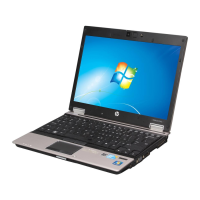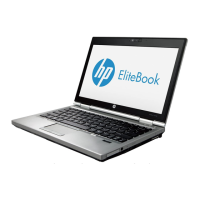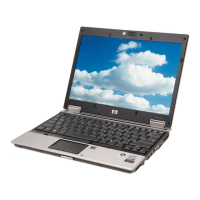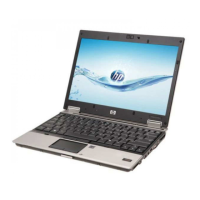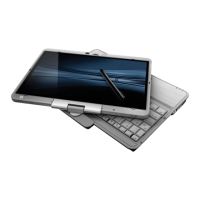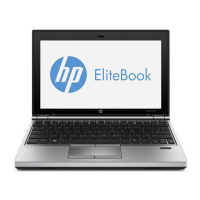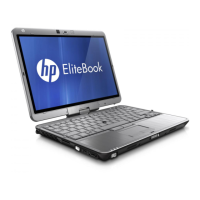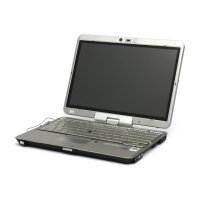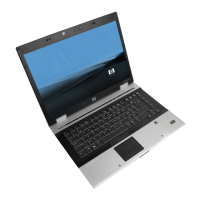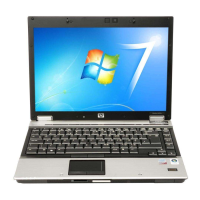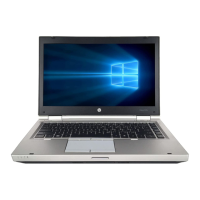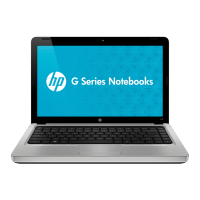





Do you have a question about the HP EliteBook 2560p and is the answer not in the manual?
| Bus type | DMI |
|---|---|
| Stepping | J1 |
| Tjunction | 100 C °C |
| Processor cache | 4 MB |
| Processor cores | 2 |
| Processor model | i7-2640M |
| System bus rate | 5 GT/s |
| Processor family | Intel® Core™ i7 |
| Processor series | Intel Core i7-2600 Mobile Series |
| Processor socket | - |
| Processor threads | 4 |
| Processor codename | Sandy Bridge |
| Processor frequency | 2.8 GHz |
| Processor cache type | Smart Cache |
| Processor lithography | 32 nm |
| Processor manufacturer | Intel |
| Processor front side bus | - MHz |
| PCI Express slots version | 2.0 |
| Processor boost frequency | 3.5 GHz |
| Processor operating modes | 64-bit |
| ECC supported by processor | No |
| PCI Express configurations | 1x16, 2x8 |
| Thermal Design Power (TDP) | 35 W |
| CPU multiplier (bus/core ratio) | 28 |
| Maximum number of PCI Express lanes | 16 |
| Motherboard chipset | Intel® QM67 Express |
| HDD speed | 7200 RPM |
| HDD interface | SATA II |
| Storage media | HDD |
| Optical drive type | DVD Super Multi DL |
| Card reader integrated | Yes |
| Total storage capacity | 320 GB |
| Compatible memory cards | MMC, SD |
| Number of HDDs installed | 1 |
| Display diagonal | 12.5 \ |
| Display resolution | 1366 x 768 pixels |
| Native aspect ratio | 16:9 |
| Memory slots | 2x SO-DIMM |
| Internal memory | 4 GB |
| Memory clock speed | 1333 MHz |
| Internal memory type | DDR3-SDRAM |
| Maximum internal memory | 16 GB |
| Type | PC |
| Intel segment tagging | Enterprise |
| On-board graphics card ID | 0x116 |
| Discrete graphics card model | Not available |
| On-board graphics card model | Intel® HD Graphics 3000 |
| On-board graphics card family | Intel® HD Graphics |
| On-board graphics card base frequency | 650 MHz |
| On-board graphics card dynamic frequency (max) | 1300 MHz |
| Audio system | SRS PS |
| Pointing device | Touchpad + Pointing Stick |
| Wi-Fi standards | 802.11a, 802.11b, 802.11g |
| Bluetooth version | 2.1+EDR |
| Cabling technology | 10/100/1000Base-T(X) |
| Top Wi-Fi standard | Wi-Fi 4 (802.11n) |
| Networking features | Gigabit Ethernet |
| Ethernet LAN data rates | 10, 100, 1000 Mbit/s |
| Trial software | Norton Internet Security 2011 |
| Operating system installed | Windows 7 Professional |
| Charging port type | DC-in jack |
| USB 2.0 ports quantity | USB 2.0 ports have a data transmission speed of 480 Mbps, and are backwards compatible with USB 1.1 ports. You can connect all kinds of peripheral devices to them. |
| Firewire (IEEE 1394) ports | 0 |
| Battery capacity | 55 Wh |
| Battery life (max) | 8.5 h |
| Number of battery cells | 6 |
| AC adapter power | 65 W |
| Operating temperature (T-T) | 5 - 35 °C |
| Sustainability certificates | ENERGY STAR |
| Processor code | SR03R |
| Processor ARK ID | 53464 |
| Processor package size | 37.5 x 37.5 (rPGA988B); 31 x 24 (BGA1023) mm |
| Supported instruction sets | AVX |
| Intel Identity Protection Technology version | 1.00 |
| Country of origin | China |
| Depth | 209 mm |
|---|---|
| Width | 305.2 mm |
| Height | 27.4 mm |
| Weight | 1670 g |
Learn how to identify hardware installed in your computer using Device Manager.
Details on top components like the TouchPad, its indicator, zone, and buttons.
Explanation of the TouchPad, Caps Lock, Power, and Wireless indicator lights.
Identifies computer speakers and the power button functions.
Description of ESC, Fn, Windows logo, applications, navigation, and action keys.
Details on internal microphone, webcam, and webcam light.
Identifies optical drive, USB port, RJ-11 jack, AC adapter light, and security slot.
Identifies external monitor port, vent, HDMI, RJ-45, USB ports, audio jacks, and media slot.
Identifies battery bay, release latch, vents, memory compartment, and hard drive bay.
Information on the computer's wireless antennas and optimal transmission.
Details on power cord, AC adapter, and battery.
Explanation of service tag, regulatory, and authenticity labels.
Explanation of wireless local area network (WLAN) and Bluetooth devices.
Steps for setting up a WLAN and connecting to it.
Procedure for connecting to a WLAN, including security key entry.
Common wireless connection problems and solutions.
Detailed guide on using the TouchPad for navigation and gestures.
Information on using the keyboard, action keys, and hotkeys.
Introduction to multimedia capabilities like optical drive, speakers, and webcam.
Using audio features, adjusting volume, and connecting external audio devices.
Using video features, connecting external monitors, projectors, and HDMI devices.
Identifying, using, and selecting discs for the optical drive.
Guide to using the webcam, tips, and adjusting properties.
Solutions for common multimedia issues like disc playback and driver problems.
Configuring power-saving states like Sleep and Hibernation, and using power plans.
Connecting and using the AC adapter for power.
Managing battery charge, charging, calibration, and replacement.
Recommended procedure for safely shutting down the computer.
Precautions and guidelines for handling fragile computer drives.
Steps to improve hard drive performance using Disk Defragmenter and Cleanup.
Instructions for safely removing and replacing the computer's hard drive.
Connecting and removing USB devices.
Inserting and removing digital cards in the media slot.
Step-by-step instructions for installing or replacing memory modules.
Overview of security features like passwords, firewall, and antivirus.
Guidelines for setting and managing passwords in Windows and Setup Utility.
Using antivirus and firewall software for system protection.
Importance of installing critical updates from Microsoft.
How to start, navigate, and use the Setup Utility for system configuration.
Overview of Main, Security, System Configuration, and Diagnostics menus.
Procedure for determining and downloading BIOS updates.
Steps to download and install software and drivers from the HP website.
HP recommends creating recovery discs for system restoration.
Regularly backing up system data and files.
Creating and restoring system points to reverse changes.
Procedures for recovering the system from discs or a partition.
